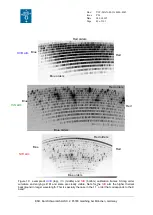
Doc:
Issue
Date
Page
VLT-MAN-ESO-14650-4942
P96
24.06.2015
34 of 161
ESO, Karl-Schwarzschild-Str. 2, 85748 Garching bei München, Germany
1
1 .5
2
2 .5
3
0
1
2
3
4
5
6
H A
A
ir
m
a
s
s
v
a
ri
a
ti
o
n
4 0
3 0
2 0
1 0
0
-1 0
-2 0
-3 0
-4 0
-5 0
-6 0
-7 0
-8 0
From this plot about the airmass variation, one can see that for decli40 degrees, the
airmass will change from AM=2.4 to 2.5 in 1h so a relative small change but it means for the
UVB arm a dispersion between the blue and red orders of about 5” while the parallactic angle
will change by ~110 degrees in 1 h. As a consequence for such observation it is
recommended to do short exposures and do some re-acquisitions to setup frequently the slit
at the parallactic angle. If it is not performed after few minutes, the main dispersion direction
will imply that some orders will be missed.
For declination –50 degrees, in 1h (1 HA) the airmass will change from AM=1.12 to 1.13,
therefore the dispersion for the UVB arm between the blue and red orders is about 1” while
the parallactic angle changes by ~35 degrees. It means that the orders at the border will be
affected by flux losses but less important that in the case of the decli 40 degrees.
In case of large dispersion, it could be better to use the stare mode with the parallactic angle
and with short OBs or to use the nodding with a smaller nodding throw (by default 5”).






























